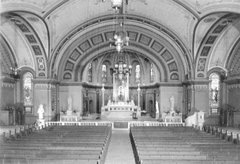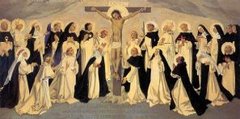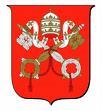Loaves and Fishes
Fashionable Priests and the "Miracle of Sharing"
By Steve RayOne Sunday I visited a parish in another city and learned something new. The multiplication of loaves didn’t really happen. The greedy people following Jesus in the wilderness had loaves and fishes stuffed up under their robes. The disciples didn’t know about this surplus of hidden food, but this parish priest did!
Although the priest said he was taught in seminary that Jesus kept pulling bread and fish out of the basket, he learned the real truth from the natives in Mexico. They taught him that the Gospel writers misunderstood what really happened. What really happened is that Jesus preached to the crowd about caring and sharing and they responded by bringing out food from under their robes that they had been hiding from each other. Once everyone learned how to share, there was plenty for everyone with twelve basketfuls left over.
The story was told with great humor and passion, but the denial of the miraculous and the undermining of the clear intent of Scripture was accomplished nonetheless. And in the course of telling a good story, the priest actually placed the onus of this false teaching in the laps of the poor people in Mexico.
Unhappily, this priest is not alone in his misunderstanding. It seems this interpretation has quite a following. I’ve read it in books and magazines, and I’ve heard it in other homilies. For some theologians and priests, the real miracle was not the multiplication of loaves, but the act of caring. Jesus was able to convince selfish people to share: the real miracle.
Let’s take a look at a few of the many problems with this interpretation. There are six accounts of feeding the multitudes given in the Gospels (See "Read the Different Accounts" on page 24). Jesus fed the people on at least two occasions—once 5,000 men and another time 4,000 men; once with five loaves and two fish and again with seven loaves and a few fish; once with twelve baskets of remaining bread and in another five baskets.Was Jesus Unaware of Custom?
Jesus and the disciples knew the people and the customs of the times. If it was customary for people to carry hidden food under their robes, Jesus and the disciples would have known. But Jesus and his disciples—unlike this "wiser-than-Jesus" priest—didn’t realize there was a hidden treasure of food.
The Twelve came to Jesus and made a request. They needed food to feed hungry people, or they needed to send them away. They never mentioned or taught anything about hidden food and sharing. Are we to believe that if Jesus intended the message to be about sharing that at least one of the writers would not have stated so or shared the homily Jesus preached about sharing?
Rather, three of the Gospel writers say "Send the crowd away, that they may go into the surrounding villages and countryside and find lodging and get something to eat; for here we are in a desolate place." The priest seemed to know something the disciples were totally oblivious to—there was plenty of food and no one needed to go into town to find food. Silly disciples!
Jesus and the disciples knew there was no abundance of bread hiding in secret picnic baskets. As St. Jerome said, "Wherein he calls the apostles to breaking of bread, that the greatness of the miracle might be more evident by their testimony that they [the people] had none [no food]" (Thomas Aquinas, Catena Aurea, I.2).
But if that is not enough, let’s look carefully at the words of Jesus in Matthew 15:32: "Then Jesus called his disciples to him and said, ‘I have compassion on the crowd, because they have been with me now three days, and have nothing to eat; and I am unwilling to send them away hungry, lest they faint on the way’" (cf. Mark 8:2-4).
Jesus states clearly that the people had been with him in the deserted area for three days. Even if they had originally brought hidden food, it would have been eaten over the three days of being in the wilderness. Jesus clearly stated that they had no food.
It doesn’t seem likely that Jesus was completely ignorant of the situation and was mistaken in thinking the people were really hungry. We can’t believe that Jesus knew there was plenty of hidden food and was just lying about the situation to make a point. Why should I believe what a priest says rather than what Jesus says?Where’s the Sharing Lesson?
The line goes something like this: "The people had plenty of food but they were hoarding it. Jesus taught them to share so they all pulled out their surplus of food from under their robes and everyone shared with his neighbor. That is the lesson! Jesus did not do a physical miracle; the real miracle was convincing selfish people to share with others."
But read the Gospel accounts of the multiplication of loaves and fishes, and see if you can find even a hint of this "sharing interpretation." Nothing is said about Jesus teaching the crowds at this point, much less that he taught them about sharing. Scripture never mentions or even hints that Jesus exhorted everyone to pull up their robes to reveal their hidden stashes of food. In fact it is never even implied.
Except for the Resurrection, the multiplication of loaves is the only miracle told in all four Gospels. It was considered important enough to include in all four. And here we come to the next big problem. If these events were so important, why do the writers not offer the slightest clue that sharing was the primary import of the event?
Interestingly, Jesus does not address the crowd at all. He speaks only to his disciples. The dialogue goes on between Jesus and his disciples. The only time the crowd is addressed is when they are told to sit down in groups—not to teach them generosity. So, where are we told that Jesus taught them about sharing? If he did teach them to share their hidden food, why did the Gospel writers fail to inform us—in six separate accounts? If this was the main point of the story, shouldn’t it show up at least once?Where Did It Come From?
Matthew informs us about two separate occasions of feeding the multitudes (Matt. 14 and 15). Matthew 15:36 makes it clear what happened and where the miraculous bread came from. It came from the hands of Jesus, not the people. Matthew writes "[Jesus] took the seven loaves and the fish; and giving thanks, he broke them and started giving them to the disciples, and the disciples gave them to the people."
Is there any indication here that the bread just appeared among the crowd and kept growing as everyone pulled out food and began to share? Did the "multiplication" begin from the hands of the people to the mouths of their neighbor? Of course not. Nor did the bread start appearing first in the hands of the generous crowd and move to the hands of the disciples then to the hands of Jesus. It was the other way around. It went from the hands of Jesus who took, blessed, broke, and gave it into the hands of the disciples, who passed it to the people.
As St. Jerome affirmed, "The multitude receives the food from the Lord through the apostles; as it follows, and he gave the loaves to his disciples, and the disciples to the multitude" (Thomas Aquinas, Catena Aurea, I.2).
It took a lot of bread and fish to feed 10,000–20,000 people or more. (Jesus fed 5,000 men on one occasion, not counting women and children. Add one woman and one child for each man and you already are at 15,000.) The fragments of bread left over filled many baskets. The Gospel writers even say the remaining bread represented a "superabundance." What was the source of the remaining superabundance? Had the remaining fragments come from the picnic baskets? Or were the fragments left over from the loaves blessed and multiplied by Jesus? Here is what John says:So they gathered them up, and filled twelve baskets with fragments from the five barley loaves which were left over by those who had eaten. Therefore when the people saw the sign which he had performed, they said, "This is truly the Prophet who is to come into the world." (John 6:13-14)The people had seen a supernatural miracle (John refers to supernatural miracles as "signs" throughout his Gospel), so they declared that he was "truly the Prophet who is to come" (based on Deut. 18:15-18). And seeing the miracle they wanted to make Jesus the king (John 6:15).
Jesus, the New Moses
In the Gospels Jesus is presented as the New Moses. At the Transfiguration (interestingly, right after the miracle of the loaves and fishes), Jesus meets Moses on the mountain. They talk about his "exodus" soon to take place. Moses had led the first Exodus, passing through the Red Sea (baptism, 1 Cor. 10:1-4), and then providing miraculous bread in the wilderness (just as Jesus gave the bread in the wilderness and the Eucharist for our journey). Jesus is now the new Moses on a mountain, with a shining face, engulfed in a cloud and leading an exodus—all referring back to Moses on the mountain of Sinai.
When the miracle of the multiplication of loaves is told in the Gospel of John, it is immediately related to the manna in the wilderness. The people saw the connection between Moses and Jesus, the manna and the miraculous bread. Jesus was the Prophet who had been promised. The people wanted to make him a king, not because he taught selfish people to share, but because he had done a stupendous miracle like their ancestors had seen in the wilderness of Sinai.
Since the two events are tied together—especially by John—then we could ask, was the manna really a miracle in the wilderness of Sinai or had Moses simply taught the people to share? Did the Israelites all sneak out of their tents at night to scatter manna around the desert? Had they been hoarding manna in their tents or under their robes?
I don’t think so. God had performed a genuine, certifiable miracle and the people knew it. And they knew it with Jesus too.
As the new Moses, Jesus could do no less than the Moses of old. The people would not have been impressed with anything less than a stupendous miracle. And impressed they were! Look at their reaction: They tried to make Jesus a king. If he had just given a lesson on generosity, they would have gone around patting each other on the back—they would have been the heroes, the ones to receive praise for sharing. But they had seen the miraculous, supernatural hand of God. Jesus was the Prophet promised by God and they wanted him to be king.The Number of Perfection
John’s Gospel is a masterful composition constructed with intricate detail that holds together like a gorgeous tapestry. He opens with "the Word was God" and concludes with "My Lord and my God." Everything in between proves the divinity of Jesus. John describes seven miracles which he calls signs. He even numbers the first two signs to encourage us to keep counting. The seven are these:
- changing water into wine,
- healing the official’s son,
- healing the cripple at Bethesda,
- walking on water,
- multiplying loaves,
- healing the blind man, and
- raising Lazarus from the dead.
On the eighth day, the start of a new week, he rises from the dead—the eighth miracle/sign which shows a new beginning on the eighth day. These signs point to the divinity of our Lord. He uses seven because that is the number of perfection—seven days, seven sacraments, etc. When God makes an oath in Hebrew, it is literally "God sevens himself." John’s use of seven signs is remarkable. To delete one of the miracles and say it is just a "caring, sharing" moment among people in the crowd is to destroy the symmetry John weaves into his Gospel. You end up with six miracles, and in Scripture six is the number of man and incompleteness.
Violating Scripture in one place has the effect of a ball of yarn rolling down a hill. It begins to unravel everything and to do violence to the fabric of the Scriptures and the faith.Who Do You Believe?
Each Gospel account of the feeding the thousands was intended to report a divine miracle. In other words, the four Gospel writers did not set out deceive their readers. If, however, we accept what these homilists propose, denying the miraculous in these stories, then we are accusing the eyewitness Gospel writers of one of two things: 1) being ignorant of what really happened, or 2) deliberating trying to deceive their readers.
Even if it were not a miraculous multiplication of loaves, the writers thought it was miraculous and wrote to inform us that they had seen what they thought was a miracle. And those reading the accounts thought the writers intended to report a real miracle. Eyewitnesses were still alive when the Gospel accounts were written. If there had been no miracle, they would have scoffed at the New Testament writings and exposed them as lies.
And believing Jesus actually performed a miracle was not just the universal belief of the early Church. For 2,000 years, readers have believed not only that the writers intended to relay their eyewitness account of a miracle but that Jesus actually performed such a miracle.
What actually happened in the wilderness long ago? There are only three options: 1) there was no miracle, only "sharing"—the Gospel writers were ignorant and just thought it was actually a miracle; 2) there was no miracle, only "sharing" and the writers conspired to deceive their readers into thinking it was a miracle; or 3) it was a miracle, and the Gospel writers reported it accurately.
The correct option is not as complicated as some people seem to think. We must also remember that as the Second Vatican Council taught in Dei Verbum that all that the Scripture writers affirm as true is without error. The passage about the multiplication of the loaves and fish certainly affirms a miracle.Do You Not Yet Understand?
It seems like Jesus is asking this question again, this time to those who stray from the truth and fail to listen and understand. Listen to what Jesus says in the context of the multiplication of the loaves:And they discussed it with one another, saying, "We have no bread." And being aware of it, Jesus said to them, "Why do you discuss the fact that you have no bread? Do you not yet perceive or understand? Are your hearts hardened? Having eyes do you not see, and having ears do you not hear? And do you not remember? When I broke the five loaves for the five thousand, how many baskets full of broken pieces did you take up?" They said to him, "Twelve." "And the seven for the four thousand, how many baskets full of broken pieces did you take up?" And they said to him, "Seven." And he said to them, "Do you not yet understand?" (Mark 8:16-21)Steve Ray is the author of Crossing the Tiber, Upon This Rock, and St. John’s Gospel. He is also co-author of Catholic Answers’ Papacy learning guide. You may contact him through his Web site, www.catholicconvert.com.
Monday, August 18, 2008
Loaves and fishes - miracle or not?
For those who have had to sit through a homily which proposed that no miracle occurred in feeding 5000 with 5 loaves and two fishes, here is Steve Ray's answer, which was published in This Rock, January 2008.
Subscribe to:
Post Comments (Atom)





















No comments:
Post a Comment